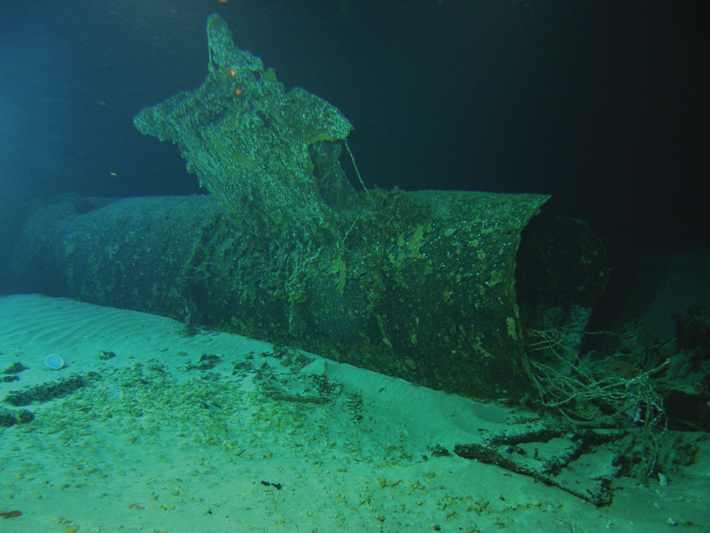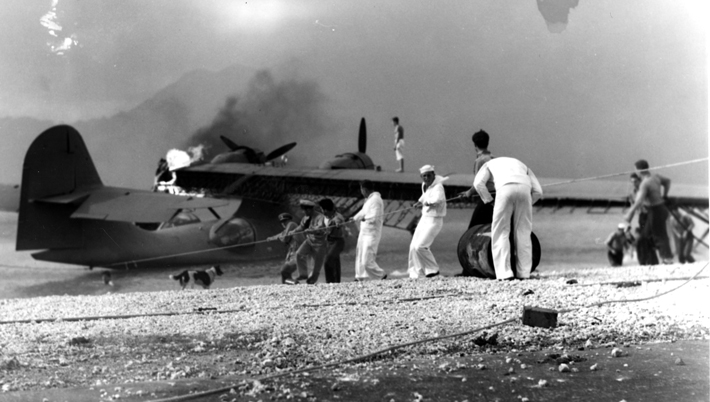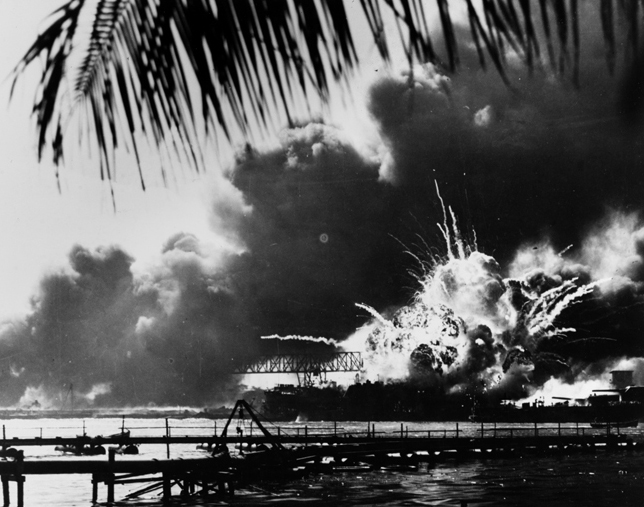The Battleships
USS Arizona and USS Utah
January/February 2017
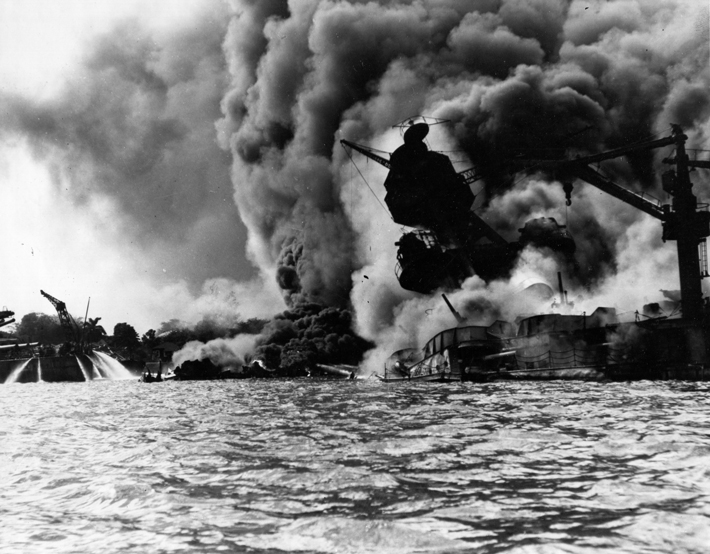
The broken remains of the battleship USS Arizona, in shallow water off Ford Island, are a war grave, a pilgrimage site, a potential environmental nightmare, and a focal point for the study of shipwrecks around the world and the archaeological landscape of World War II. Arizona, commissioned on October 16, 1916, was the second and last battleship in the Pennsylvania “super-dreadnought” class: 608 feet long, 33,000 horsepower, armed with 12 14-inch guns and around 30 smaller ones, and with armor up to 18 inches thick. It saw little action before it entered Pearl Harbor for the last time on December 6, 1941, and docked in berth F-7, where the repair ship USS Vestal pulled alongside it.
Arizona began to take fire almost as soon as the attack began, and men scrambled across the teak deck fighting fires. There are reports that its bottom was blown out by a torpedo that slid in under Vestal, around the same time that a torpedo fatally struck USS Utah, an older battleship used for anti-aircraft training. Then, at 8:10 a.m., crack Japanese bombardier Noburo Kanai loosed a 1,760-pound armor-piercing bomb that penetrated Arizona’s deck beside the No. 2 turret and detonated the forward magazine, killing 1,177 men. At 10:32 a.m., 30 minutes after the attack ended, the ship was declared untenable and abandoned. It burned for days.
Within a week, Navy divers were examining Arizona, and over the next two years they removed turrets, sensitive material, live ammunition, machinery, the masts—and 105 bodies, though those efforts were stopped due to manpower limitations, safety concerns, and the emotional toll on the divers. In December 1942 Arizona was struck from the books of commissioned ships, its remaining casualties declared buried at sea. It was one of the three ships damaged in the attack that did not return to service, along with Utah, which still sits in the harbor, and USS Oklahoma, which was refloated but sold for scrap and lost in a storm in 1947. Dave Conlin, chief of the National Park Service (NPS) Submerged Resources Center (SRC), has led recent studies of the wreck and says, “Had Arizona not been so catastrophically wounded by the attack, or Utah been righted like they were trying to do, there would be almost no indications of what happened here.”
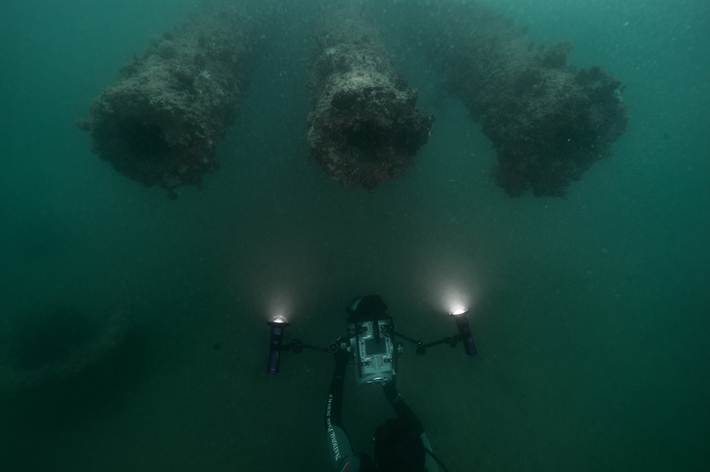
Once the salvage ended, no one systematically examined the wreck until NPS took over management of the site in 1980. Its condition at the time, according to a later NPS report, was “riddled with contradiction and mystery.” The SRC (then called the Submerged Cultural Resources Unit) and the Navy Mobile Diving and Salvage Unit One planned a series of dive seasons. The project began in 1983 with an unexpected revelation. It had been thought that all four of Arizona’s turrets had been removed or destroyed. But just aft of the explosion damage, divers found the No. 1 turret—intact. “Three battleship guns in a turret as big as a Greyhound bus, at a depth of 29 feet. How is it that they didn’t know about that?” says Conlin. “Everyone thought all the turrets had been removed. Unbelievable.”
The next year, NPS and the Navy began a foot-by-foot inspection and mapping project to assess the wreck and look for evidence of undocumented operational modifications, battle damage, and salvage efforts. This had never been attempted on a wreck of this scale. There were no guidelines to follow, no relevant experience or technology, save string, clothespins, measuring tape, plastic protractors, and some electronic measuring tools. But they had some expertise, particularly that of NPS’s Larry Nordby, whose work measuring cliff dwellings in the Southwest helped them adjust for the curvature of the ship. Those original measurements, according to Scott Pawlowski, chief of cultural and natural resources at the World War II Valor in the Pacific National Monument, “were just damn good.” They found that the hull plates had ripped outward 20 feet at the point of the explosion like an over-pressurized tin can. They retrieved potentially explosive materials, observed items from dishes to a Coke bottle to a fire hose, and could not find evidence of a torpedo strike. Of diving on the wreck during this time, when he was with NPS, NOAA’s James Delgado says, “It connects you to the human events that happened, those details that are intimate and personal, beyond the iconic image of a burning battleship.”
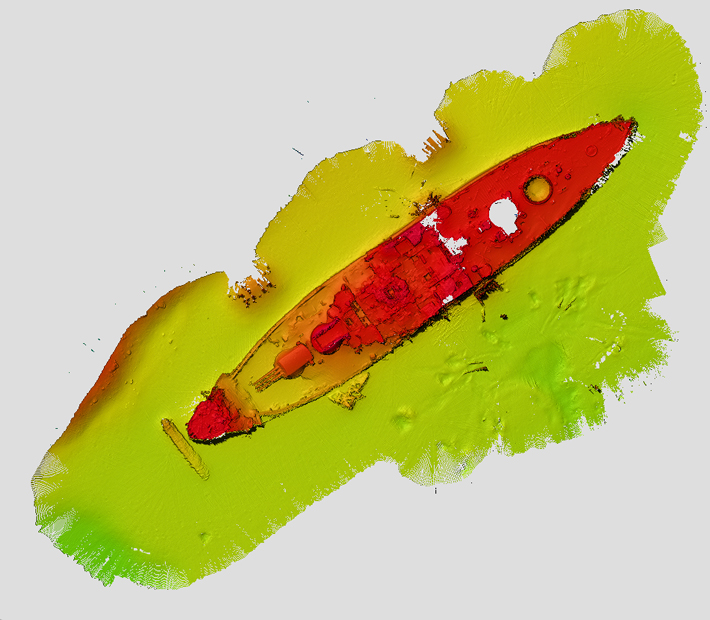 The project continued in the following years with the mapping of Utah, an often-forgotten casualty of the attack, and an unsuccessful scan for crashed aircraft and submarines. Of major concern were Arizona’s structural integrity and the estimated 500,000 gallons of bunker C fuel oil inside. Around a gallon a day still leaks from the wreck, a bright sheen visible to every visitor to the memorial. Another phase of research began around 2000 and applied the latest technology and modeling to understand how the ship is changing. Arizona has since become the best-characterized metal wreck in the world. Working with the Navy, National Institute of Standards and Technology, University of Nebraska, U.S. Geological Survey, and other partners, NPS created a detailed model of the stresses on the ship. They have studied the microbes, chemical decay products, water flow, the sediment and rock beneath it. They’re using sonar, 3-D imaging, hyperspectral cameras. “We’re bringing all these data sets together,” says Pawlowski.
The project continued in the following years with the mapping of Utah, an often-forgotten casualty of the attack, and an unsuccessful scan for crashed aircraft and submarines. Of major concern were Arizona’s structural integrity and the estimated 500,000 gallons of bunker C fuel oil inside. Around a gallon a day still leaks from the wreck, a bright sheen visible to every visitor to the memorial. Another phase of research began around 2000 and applied the latest technology and modeling to understand how the ship is changing. Arizona has since become the best-characterized metal wreck in the world. Working with the Navy, National Institute of Standards and Technology, University of Nebraska, U.S. Geological Survey, and other partners, NPS created a detailed model of the stresses on the ship. They have studied the microbes, chemical decay products, water flow, the sediment and rock beneath it. They’re using sonar, 3-D imaging, hyperspectral cameras. “We’re bringing all these data sets together,” says Pawlowski.
“What we learned is that, yes, Arizona is corroding. Yes, Arizona is rusting. And yes, Arizona is changing,” says Conlin, “but it’s changing very, very slowly, and the best science that we have tells us that Arizona will still have significant structural integrity for at least another 150 years.” The risk of a catastrophic spill is low, he adds. Battleships don’t hold oil in a single tank, but in hundreds of cells. A recent SRC study found that, of the several places where oil emerges from the wreck, only one appears to be closely connected to a fuel storage area. The rest of the leaking oil follows a circuitous path through interior spaces, which suggests that it is distributed around the ship. Furthermore, it is thought that the oil inside inhibits the degradation of the metal and provides a buoyant force for its structure. And there’s no way to remove the oil without deeply impacting or damaging a war grave. “We are getting smarter about how we can understand Arizona,” Conlin says, “and also how we can manage Arizona.”
Another recent project has involved entering the wreck with an innovative new remotely operated vehicle developed by the Advanced Imaging and Visualization Lab at Woods Hole Oceanographic Institution, which will be used to create 3-D models of some interior spaces of the ship, measure sediment accumulation, and collect microbial communities from inside. Such sensitive work, Conlin explains, is not undertaken lightly and is not just to feed curiosity, but is in service of preservation and stewardship of the wreck and others like it. “What started as an iconic battleship, the way it was in the 1980s, becomes something more,” says Delgado. “The development of the field of marine, maritime, and nautical archaeology—you can really see it in a microcosm with the way work on Arizona has advanced.”
Advertisement
IN THIS ISSUE
From the Trenches
Proteins Solve a Hominin Puzzle
Off the Grid
A Pharaoh’s Last Fleet
The Curse of a Medieval English Well
Discovering Terror
Hungry Minds
Guide to the Afterlife
Japan’s Early Anglers
A Removable Feast
Blue Collar in Ancient Peru
The Monkey Effect
Figure of Distinction
Death by Boomerang
Artifact
How not to get frostbite
Advertisement

Recent Issues
-
 May/June 2024
May/June 2024
-
 March/April 2024
March/April 2024
-
 January/February 2024
January/February 2024
-
 November/December 2023
November/December 2023
-
 September/October 2023
September/October 2023
-
 July/August 2023
July/August 2023
-
 May/June 2023
May/June 2023
-
 March/April 2023
March/April 2023
-
 January/February 2023
January/February 2023
-
 November/December 2022
November/December 2022
-
 September/October 2022
September/October 2022
-
 July/August 2022
July/August 2022
-
 May/June 2022
May/June 2022
-
 March/April 2022
March/April 2022
-
 January/February 2022
January/February 2022
-
 November/December 2021
November/December 2021
-
 September/October 2021
September/October 2021
-
 July/August 2021
July/August 2021
-
 May/June 2021
May/June 2021
-
 March/April 2021
March/April 2021
-
 January/February 2021
January/February 2021
-
 November/December 2020
November/December 2020
-
 September/October 2020
September/October 2020
-
 July/August 2020
July/August 2020
-
 May/June 2020
May/June 2020
-
 March/April 2020
March/April 2020
-
 January/February 2020
January/February 2020
-
 November/December 2019
November/December 2019
-
 September/October 2019
September/October 2019
-
 July/August 2019
July/August 2019
-
 May/June 2019
May/June 2019
-
 March/April 2019
March/April 2019
-
 January/February 2019
January/February 2019
-
 November/December 2018
November/December 2018
-
 September/October 2018
September/October 2018
-
 July/August 2018
July/August 2018
-
 May/June 2018
May/June 2018
-
 March/April 2018
March/April 2018
-
 January/February 2018
January/February 2018
-
 November/December 2017
November/December 2017
-
 September/October 2017
September/October 2017
-
 July/August 2017
July/August 2017
-
 May/June 2017
May/June 2017
-
 March/April 2017
March/April 2017
-
 January/February 2017
January/February 2017
-
 November/December 2016
November/December 2016
-
 September/October 2016
September/October 2016
-
 July/August 2016
July/August 2016
-
 May/June 2016
May/June 2016
-
 March/April 2016
March/April 2016
-
 January/February 2016
January/February 2016
-
 November/December 2015
November/December 2015
-
 September/October 2015
September/October 2015
-
 July/August 2015
July/August 2015
-
 May/June 2015
May/June 2015
-
 March/April 2015
March/April 2015
-
 January/February 2015
January/February 2015
-
 November/December 2014
November/December 2014
-
 September/October 2014
September/October 2014
-
 July/August 2014
July/August 2014
-
 May/June 2014
May/June 2014
-
 March/April 2014
March/April 2014
-
 January/February 2014
January/February 2014
-
 November/December 2013
November/December 2013
-
 September/October 2013
September/October 2013
-
 July/August 2013
July/August 2013
-
 May/June 2013
May/June 2013
-
 March/April 2013
March/April 2013
-
 January/February 2013
January/February 2013
-
 November/December 2012
November/December 2012
-
 September/October 2012
September/October 2012
-
 July/August 2012
July/August 2012
-
 May/June 2012
May/June 2012
-
 March/April 2012
March/April 2012
-
 January/February 2012
January/February 2012
-
 November/December 2011
November/December 2011
-
 September/October 2011
September/October 2011
-
 July/August 2011
July/August 2011
-
 May/June 2011
May/June 2011
-
 March/April 2011
March/April 2011
-
 January/February 2011
January/February 2011
Advertisement




